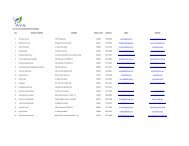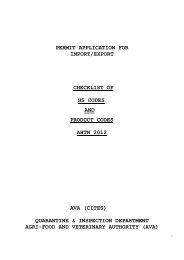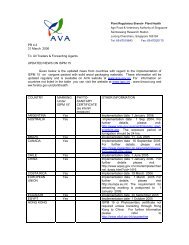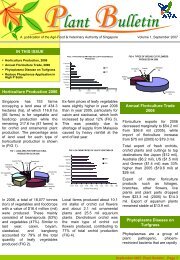use of koji and protease in fish sauce fermentation - Agri-Food ...
use of koji and protease in fish sauce fermentation - Agri-Food ...
use of koji and protease in fish sauce fermentation - Agri-Food ...
Create successful ePaper yourself
Turn your PDF publications into a flip-book with our unique Google optimized e-Paper software.
S<strong>in</strong>gapore J Pri Ind 32: 19-29 2005/06<br />
Sample<br />
number<br />
TABLE 1<br />
COMPOSITION OF MATERIALS FOR PREPARATION OF FISH SAUCE<br />
Fish type Protease (%<br />
<strong>of</strong> <strong>fish</strong> weight)<br />
Monitor<strong>in</strong>g <strong>of</strong> Fermentation Process<br />
A series <strong>of</strong> chemical tests were carried out to monitor<br />
the <strong>fermentation</strong> process. A small amount <strong>of</strong> the<br />
liquid from the <strong>fermentation</strong> mixture was collected<br />
regularly for chemical analysis. Acidity I, acidity II,<br />
formol-N <strong>and</strong> total soluble solids tests were carried<br />
out weekly while pH measurements were done<br />
fortnightly. At the end <strong>of</strong> <strong>fermentation</strong>, the yield <strong>of</strong><br />
<strong>fish</strong> <strong>sauce</strong> was determ<strong>in</strong>ed <strong>and</strong> analyses <strong>of</strong> total<br />
nitrogen (Total-N), volatile basic nitrogen (VBN),<br />
sodium chloride <strong>and</strong> am<strong>in</strong>o acid composition <strong>of</strong> the<br />
<strong>fish</strong> <strong>sauce</strong> were conducted.<br />
The pH was measured by Istek pH meter, Model<br />
725P. Acidity I <strong>and</strong> Acidity II were determ<strong>in</strong>ed by the<br />
analytical method for Japanese soy <strong>sauce</strong> (Okuhara,<br />
1985). The content <strong>of</strong> am<strong>in</strong>o-type nitrogen were<br />
determ<strong>in</strong>ed by the Formol-N method (Official Method<br />
<strong>of</strong> Miso Analysis, 1968). Total soluble solids was<br />
measured by us<strong>in</strong>g h<strong>and</strong> refractometer (Atago, Type<br />
N1 (0 – 32%) <strong>and</strong> Type N2 (28 – 62%)).<br />
The yield <strong>of</strong> <strong>fish</strong> <strong>sauce</strong> was measured by filtration <strong>of</strong><br />
the whole <strong>fermentation</strong> mixture at the end <strong>of</strong> the<br />
<strong>fermentation</strong> period. The weight <strong>of</strong> liquid obta<strong>in</strong>ed<br />
from the filtration would be calculated aga<strong>in</strong>st the <strong>fish</strong><br />
weight. Sodium chloride content measurement was<br />
done by potentiometric titration with 0.1 N silver<br />
nitrate (AOAC, 1980). Total-N was determ<strong>in</strong>ed by<br />
Kjeldahl method <strong>and</strong> VBN was determ<strong>in</strong>ed by<br />
Conway microdiffusion method (Conway, 1950).<br />
Am<strong>in</strong>o acid composition was determ<strong>in</strong>ed us<strong>in</strong>g high<br />
pressure liquid chromatography by the <strong>Food</strong> <strong>and</strong><br />
Nutrition Branch, Veter<strong>in</strong>ary Public Health Division,<br />
Water (% <strong>of</strong><br />
<strong>fish</strong> weight)<br />
22<br />
Koji (% <strong>of</strong> <strong>fish</strong>water<br />
mixture<br />
weight)<br />
<strong>Agri</strong>-<strong>Food</strong> <strong>and</strong> Veter<strong>in</strong>ary Authority <strong>of</strong> S<strong>in</strong>gapore.<br />
RESULTS AND DISCUSSION<br />
Changes <strong>in</strong> Chemical Composition dur<strong>in</strong>g<br />
Fermentation Process<br />
pH, Acidity I<br />
The pH decreased from 5.51 <strong>and</strong> 5.67 respectively for<br />
hard-tail <strong>and</strong> round scad at the beg<strong>in</strong>n<strong>in</strong>g <strong>of</strong><br />
<strong>fermentation</strong> to 5.15 <strong>and</strong> 5.06 at the end <strong>of</strong><br />
<strong>fermentation</strong> (Fig 3). Note that <strong>in</strong> <strong>fish</strong> <strong>sauce</strong><br />
process<strong>in</strong>g, most <strong>of</strong> the <strong>fermentation</strong> occurr<strong>in</strong>g is<br />
lactic acid <strong>fermentation</strong>. This was shown further by<br />
the measurement <strong>of</strong> acidity I, which is correlated with<br />
the amount <strong>of</strong> lactic acid dur<strong>in</strong>g <strong>fish</strong> <strong>sauce</strong><br />
<strong>fermentation</strong> (Fig 4). Acidity I was <strong>use</strong>d to roughly<br />
<strong>in</strong>dicate the adequacy <strong>of</strong> <strong>fermentation</strong>, i.e.<br />
<strong>fermentation</strong> process could cease once the acidity I<br />
reached 10 ml NaOH.<br />
Acidity II, Formol-N<br />
Salt (% <strong>of</strong> <strong>fish</strong>water<br />
mixture<br />
weight)<br />
RS Round scad 1.0 30.0 25.0 16.0<br />
HT Hard-tail 1.0 30.0 25.0 16.0<br />
Acidity II measures the total am<strong>in</strong>o acid level <strong>and</strong><br />
formol-N test measures the am<strong>in</strong>o-type nitrogen. As<br />
<strong>fermentation</strong> progresses, prote<strong>in</strong> is broken down to<br />
am<strong>in</strong>o acids, affect<strong>in</strong>g the flavour <strong>of</strong> the product. The<br />
greater the am<strong>in</strong>o acid content <strong>in</strong> the product, the<br />
more flavourful the product will be, though the<br />
overall am<strong>in</strong>o acid composition still plays an<br />
important part <strong>in</strong> determ<strong>in</strong><strong>in</strong>g overall flavour balance.<br />
As <strong>fermentation</strong> proceeds, the acidity II <strong>and</strong> formol-N<br />
values should <strong>in</strong>crease until a certa<strong>in</strong> extent, then<br />
stabilize.
















